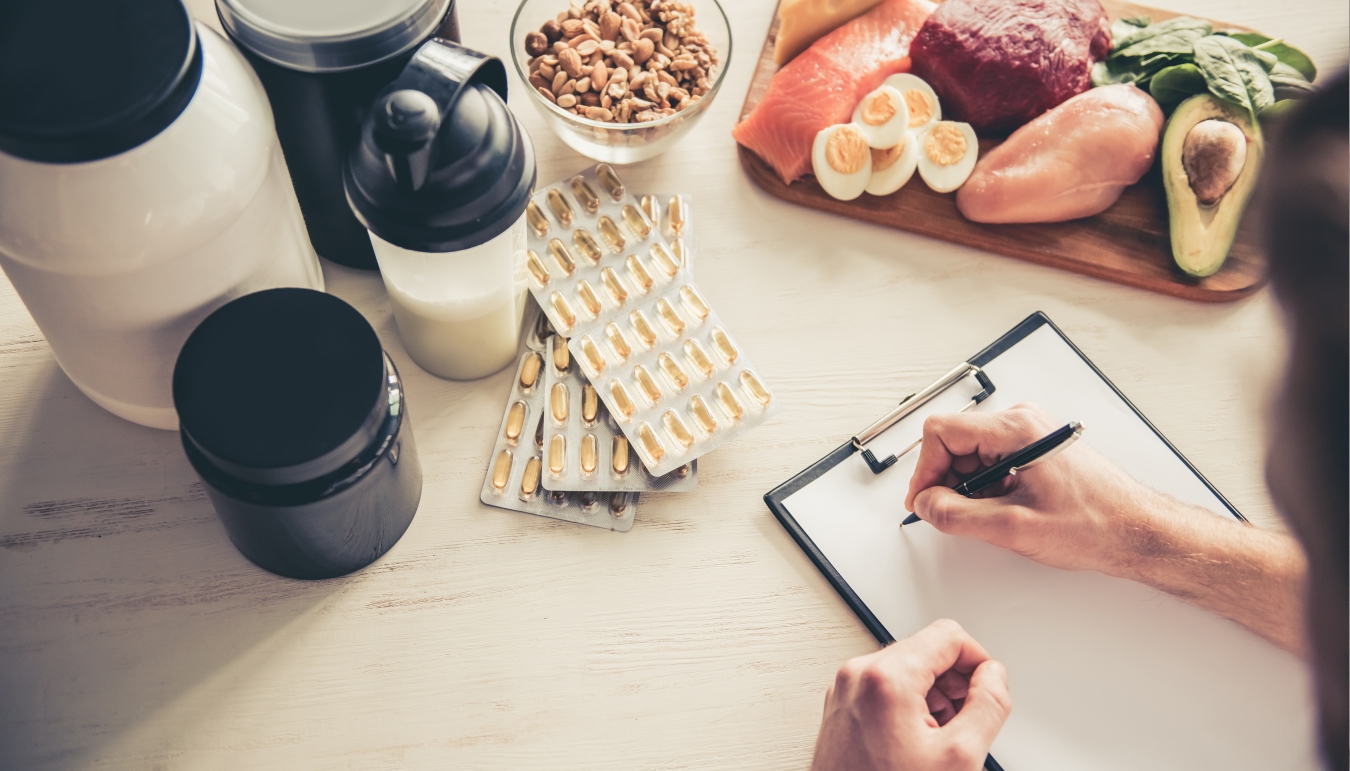Bone Health for Athletes: The Importance of Proper Nutrition and Training
- byAdmin
- 27 August, 2024
- 20 Mins

From sprinters to swimmers, athletes know the importance of maintaining peak performance. But beyond muscle strength and agility, there's an often-overlooked factor that's just as critical: bone health. In this guide, we'll explore how the right training and nutrition can help you achieve optimal bone health, whether you're a weekend jogger or an ultramarathon runner.
Understanding the Importance of Bone Health
Our bones play a pivotal role in our body, not just structurally but functionally too. While many of us may associate bone health with ageing, younger people such as athletes need to be mindful, too. Maintaining optimal bone health ensures better athletic performance and reduces the chances of injuries like stress fractures and osteoporosis.
Physical activity plays a key role in bone health from a young age, through adolescence, and into adulthood and has been associated with a reduction in fracture risk of up to 80%.1 Diet and nutrition are key, too. Bone is constantly being turned over and renewed, and diet has a major influence on this process.
Exercise and Bone Health: How Training Gives You Stronger Bones
There's plenty of evidence that exercise can reduce your fracture risk. But how does this process work? It all comes down to something called Wolff's Law, which states that bones adapt to the demands placed on them. For example, the bones in a tennis player's racquet-holding arm become stronger due to the higher-than-normal stresses placed on it.2 On the other hand, when gravitational forces are reduced, such as during a period of bed rest or astronauts on long space missions, bone density decreases, due to a lack of mechanical loading.3
Regular exercise and training have an indirect benefit on bone health in later life: as increased muscle strength is associated with a reduced risk of falls, a major contributor to fractures in older people.
Simply put, when we exercise, mechanical stress and gravitational forces stimulate bone formation. It does this through cells called osteoblasts, which generate new bony tissue. At the same time, this stress leads to a reduction in the number and activity of cells called osteoclasts, responsible for bone breakdown. The net result is an increase in bone mineral density.4
This doesn't apply to professional athletes only, everyone's bones can benefit from exercise. In a study of postmenopausal women, 9 months of impact training such as walking or jogging led to increased lower spine and hip bone density as well as in their femoral neck, a common site for osteoporotic fractures.1
Regular exercise and training have an indirect benefit on bone health in later life: as increased muscle strength is associated with a reduced risk of falls, a major contributor to fractures in older people.
Optimal Training for Bone Health
To maintain bone mass, The American College of Sports Medicine recommends 30-60 minutes of moderate to high-intensity, weight-bearing and jumping activities combined with resistance exercises at least 3 times per week.5
To give your bones the best chance for growth and resilience, consider the following:
- Opt for high-impact activities. For instance, running/jumping is excellent for the lower body, while activities like racquet sports can be beneficial for the upper body.
- Aim for dynamic movements over static ones.
- Break your workout into short sessions with recovery periods.
- Mix up your training types to vary the loading patterns.
- Complement your training with the right nutrition (more on this below).
For older adults, training should focus more on balance, leg strength, flexibility, and endurance training to effectively reduce the risk of falls and fractures.5
Nutrition: The Building Block of Bone Health in Athletes
The key to achieving optimal bone health lies not only in regular exercise but also in the right diet. Bone is a nutritionally modifiable structure, which means what we eat has a strong influence on our long-term bone health and bone strength.
1. Calcium: Calcium is essential for maintaining bone integrity. Dairy is the most significant source, calcium is also found in abundance in leafy greens, tinned sardines and foods fortified with calcium. For adults, an adequate calcium intake is 1000mg per day, equivalent to one cup of fortified orange juice, 220g of low-fat yoghurt, and a serving of tinned salmon with cooked kale. Getting your calcium from your diet is preferable to calcium supplementation as there are risks of kidney stones and cardiovascular problems even at low doses. Getting calcium from your diet doesn't seem to pose the same risks for kidney stones or cardiovascular events.6
2. Vitamin D: It's not enough to consume calcium; the body needs Vitamin D to absorb it effectively. Vitamin D is crucial for bones and deficiency is linked to low bone mineral density and bone injuries, including stress fractures.7 We get most of our Vitamin D through the interaction of our skin with UV light from the sun, but age, season, location, and skin pigmentation can affect this. Vitamin D deficiency is common in indoor athletes and those who don't get adequate sunlight exposure. For these groups, vitamin D supplementation has been shown to decrease the risk of stress fractures, while low vitamin D levels have been linked to a greater risk for fractures and poor performance.8, 9
In an additional boost to athletes, Vitamin D also promotes muscle mass and function, boosting the pathways responsible for protein synthesis and muscle growth and has been linked to improved strength and athletic performance in young adults.10, 11
3. Carbohydrates: Contrary to the rising popularity of low-carb diets among athletes, it's essential to acknowledge their role in bone health. A shift towards low carbohydrate-high fat diets might jeopardize bone health.7 Several studies have shown that carbohydrates can influence bone resorption, suggesting that adequate carbohydrate intake around exercise sessions could positively modify bone's response to strenuous workouts.7
4. Protein: A common dietary recommendation for athletes is higher protein consumption, considering the increased demands of athletic training. The bone turnover rate is escalated due to intense physical activity, making the need for protein even more pronounced for athletes. However, there's a caveat - higher protein, especially from animal sources, could affect bone health due to the 'acid-ash hypothesis'. This theory suggests that the body might break down bone tissue to counteract increased acidity from protein intake. While this theory hasn't been proven, it's advisable to pairing protein-rich diets with sufficient calcium is advisable.7
5. Other Vital Nutrients: Beyond calcium and vitamin D, several other nutrients deserve attention for bone health. Magnesium, phosphorus, potassium, and vitamin K are direct contributors to bone formation. Moreover, athletes should also focus on micronutrients such as silicon, manganese, copper, boron, iron, zinc, vitamins A, C, and B vitamins. These support various metabolic processes pivotal for bone health.7
Building a Foundation for Lasting Athletic Success
The journey to peak performance goes far beyond muscle training; it delves deep into the foundation of our body - our bones. Whether you're a weekend jogger or a dedicated athlete, it's vital to prioritise bone health in your training and nutrition. Embracing a comprehensive approach that through exercises and a nutrient-rich diet, you can set the stage for your personal bests and your personal wellbeing.
- Goolsby MA, Boniquit N. Bone Health in Athletes. Sports Health. 2017;9(2):108-17.
- Taylor RE, Zheng C, Jackson RP, Doll JC, Chen JC, Holzbaur KRS, et al. The phenomenon of twisted growth: humeral torsion in dominant arms of high performance tennis players. Computer Methods in Biomechanics and Biomedical Engineering. 2009;12(1):83-93.
- LeBlanc AD, Spector ER, Evans HJ, Sibonga JD. Skeletal responses to space flight and the bed rest analog: a review. J Musculoskelet Neuronal Interact. 2007;7(1):33-47.
- Hart NH, Nimphius S, Rantalainen T, Ireland A, Siafarikas A, Newton RU. Mechanical basis of bone strength: influence of bone material, bone structure and muscle action. J Musculoskelet Neuronal Interact. 2017;17(3):114-39.
- Kohrt WM, Bloomfield SA, Little KD, Nelson ME, Yingling VR. American College of Sports Medicine Position Stand: physical activity and bone health. Med Sci Sports Exerc. 2004;36(11):1985-96.
- Health NIo. Calcium: Fact Sheet for Health Professionals 2022 [updated 6th October 2022.
- Sale C, Elliott-Sale KJ. Nutrition and Athlete Bone Health. Sports Med. 2019;49(Suppl 2):139-51.
- Lappe J, Cullen D, Haynatzki G, Recker R, Ahlf R, Thompson K. Calcium and vitamin d supplementation decreases incidence of stress fractures in female navy recruits. J Bone Miner Res. 2008;23(5):741-9.
- Maroon JC, Mathyssek CM, Bost JW, Amos A, Winkelman R, Yates AP, et al. Vitamin D profile in National Football League players. Am J Sports Med. 2015;43(5):1241-5.
- Cannell JJ, Hollis BW, Sorenson MB, Taft TN, Anderson JJ. Athletic performance and vitamin D. Med Sci Sports Exerc. 2009;41(5):1102-10.
- Ward KA, Das G, Berry JL, Roberts SA, Rawer R, Adams JE, et al. Vitamin D status and muscle function in post-menarchal adolescent girls. J Clin Endocrinol Metab. 2009;94(2):559-63.


